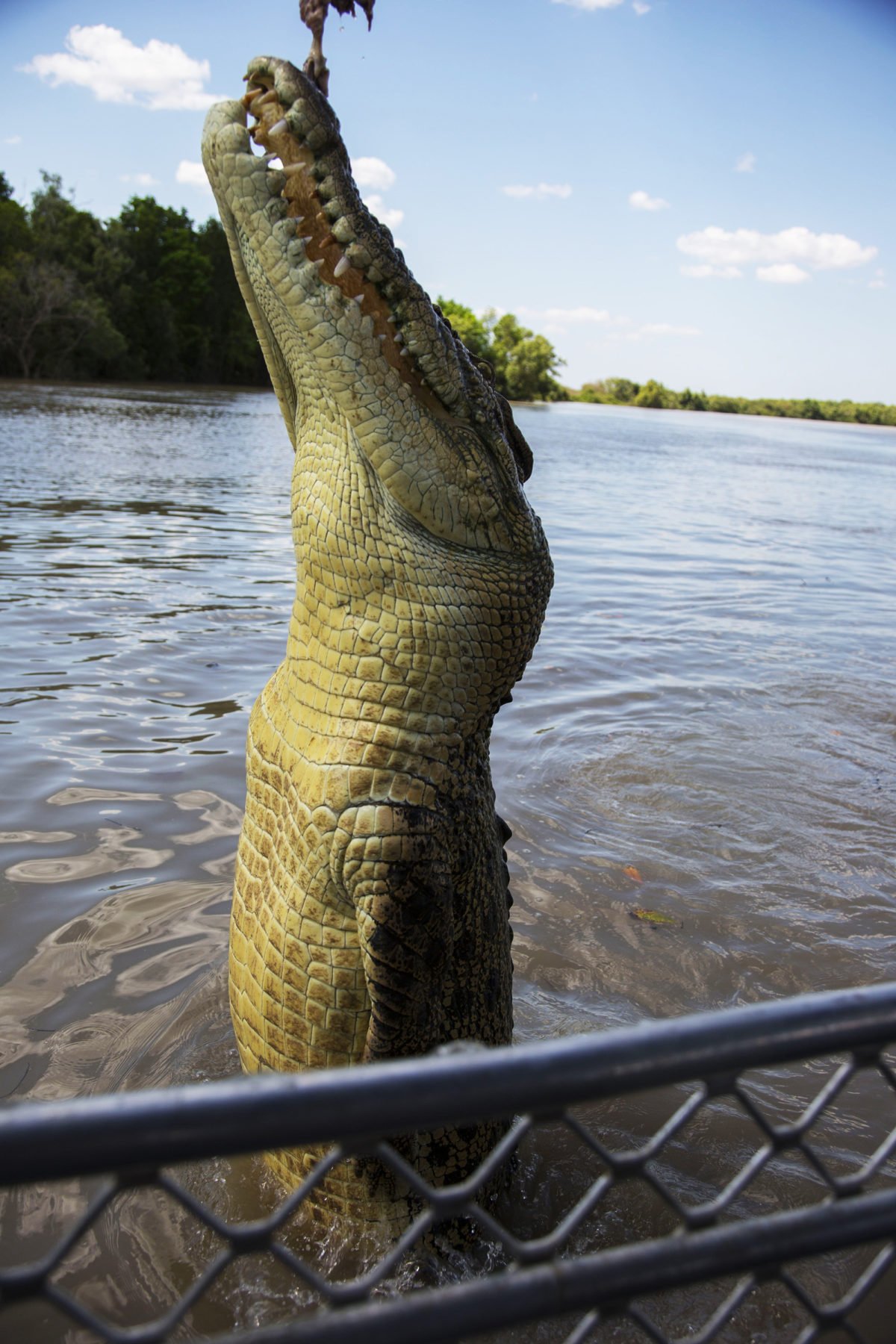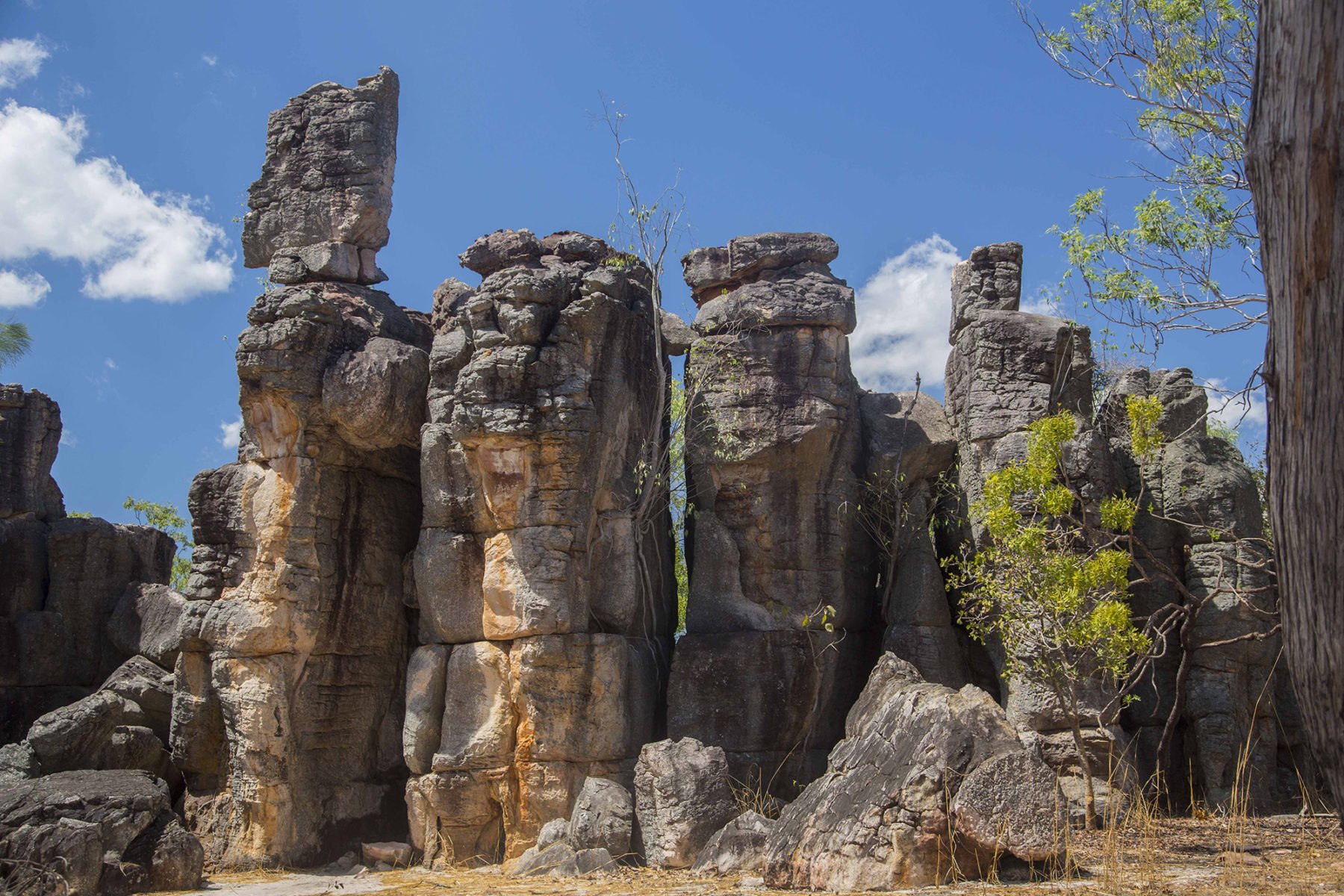Straight to the top: seven days in the NT’s Top End

The Northern Territory exudes a kind of “she’ll be right”, slightly edgy, larrikin attitude. Maybe this freewheeling, laid-back approach to life is just a front, or perhaps it stems from living way beyond the physical reach of the rest of Australia in a dynamic, dramatic and occasionally dangerous climate. It’s hard to know. But the Territory and those who call it home are different alright.
This is my first time in the Top End and whatever preconceptions I had about Darwin dissipate as I’m whisked by taxi along a busy three-lane highway from the airport to my waterfront hotel. Gleaming multi-storey office blocks and apartments reflect a cloudless blue sky and a blinding sun. I realise my notion of Darwin is woefully outdated. This is a city that has risen from the ashes on numerous occasions and today reveals scant evidence of past incarnations.
The Darwin waterfront betrays some familiarity in the distinctive bent arm of Stokes Hill Wharf elbowing into the Arafura Sea, but here’s a sight I didn’t expect – kids swimming and messing about in the water. Complete with wave pool and beach, it’s possible to swim, surf and sunbathe here, safe from crocodiles in a special enclosure. Lining the water’s edge are bars and restaurants and smart new apartment blocks; absolute waterfront and no crocs!
I have just seven days to get acquainted with the Top End and my wish list includes nature, culture, four-wheel-driving, adventure and…crocs. Nature is a constant companion up here. Even before I leave Darwin, the eerie, plaintive cry of the bush stone-curlew rings through the night outside my hotel window and fruit bats screech in the trees lining the bay. Whistling and black kites hover and wheel in the sky above for the entire week.
My first special NT moment comes as the sun dips towards the horizon across a lotus-covered lagoon of the fast-shrinking Mary River, about two hours drive east of Darwin, just off the Arnhem Highway. It is mid-August and late in the Dry – a wonderful time of year to be here. The floodplains are contracting fast, and birdlife is concentrated at lagoons and billabongs, and therefore easier to spot. The lack of humidity keeps things comfortable, and the nights are pleasant, even if the days can still feel very hot. The sunsets provide a spectacle every evening during my visit, no matter the topography of each vantage point, as I train my camera on the sun’s surprisingly fast final plummet to the horizon.
Big rivers and ancient art
I’m staying at Wildman Wilderness Lodge with its stylish safari tents that look across a private runway, beyond which is a landscape studded with termite mounds and pandanus palms. The lodge is located in the Mary River wetlands and offers private small-group tours for guests. Wildman’s guides have to be NT locals, and our man, Shane Powell, was born on the roadside a few kilometres from here when his mum left it a bit too late to get to the hospital in Darwin. Shane’s a mine of funny stories as well as information. He takes our little tour group on our first foray into Kakadu National Park.
We start with a boat trip on the East Alligator River, near Cahills Crossing, which defines the easternmost border of the park. This broad tidal river has a significant estuarine crocodile population, which makes watching vehicles power through the muddy waters of the river crossing towards Arnhem Land on the far bank all the more thrilling and I find myself dreaming of taking the same road. But that’s an adventure for another day and I return to the matter at hand.
The cruise is operated by Neville Namarnyilk and Tyrone Garnarradj of Guluyambi Cultural Cruises who point out crocs along the banks. Before long we have tallied 35. We disembark on the opposite bank within Arnhem Land, where Neville demonstrates impressive spear-throwing skills and delights us with anecdotes about his brushes with Hollywood, appearing as an extra in numerous movies shot in the region.
We head to Ubirr rock-art site. It’s afternoon and we have it more or less to ourselves. There’s cool relief under the sandstone overhang of the Main Gallery. The place’s peaceful ambience induces quiet respect among us. The images painted by the Bininj people feature Tasmanian tigers that ranged in this area millennia ago. From here we ascend 250m to the top of the plateau.
It’s not too arduous but takes a bit of effort in the hot conditions and rewards us with a 360-degree view of the Kakadu floodplains. Shane explains how different the scene would be in the Wet but even now it’s green and lush and the scene is breathtaking.
Up close with an icon
The next day we explore watercourses closer to base, such as the lodge’s own Home Billabong. In the dawn light, Australasian darters dry their wings on branches beneath overhanging paperbarks, and black-necked storks mingle with whistling ducks on the banks. Our guides point out freshwater crocodiles just below the surface and we get a close-up view of a mid-sized saltie hauled out near the jetty.
Later in the day we explore the Mary River floodplain on an airboat. These water craft, first developed for the Florida Everglades, skim across the surface and are great for getting about on shallow bodies of water at speed. Our pilot, 23-year-old Jack Abel, clearly loves his job as he pivots and weaves through carpets of lotus lilies and around stands of old paperbarks where magpie geese and egrets look on disdainfully. It’s a thrilling ride and the watery views are beautiful. Jack explains the almost magical water-resistant properties of the lotus lily leaves that blanket the surface and how the roots form a vital part of the diet of traditional inhabitants of the Top End.
For sunset we head to a bird hide at nearby Mistake Billabong and watch the sun set across swathes of lotus lilies. Amid the lush green pads and magenta blooms, elegant little comb-crested jacanas search for insects.
Next morning, it’s time to experience a contrasting landscape so we head west to Litchfield National Park. On the way, we take in a croc-jumping cruise on the Adelaide River. I’m unsure how I feel about this kind of entertainment but the operators assure me that salties naturally jump and are known for snatching calves from steep riverbanks. It’s why we are so often warned to stay 5m back from the edge of any body of water, advice I’m happy to take, but which I often see flouted. Many salties swim up to our open-sided steel boat in anticipation of a free meaty snack. They leap up to grab a dangled morsel of swamp buffalo. It’s an awesome sight. I am so close to a 6m-long specimen that I can smell its fishy breath and get a good look down its creamy gullet. The experience is heart-stopping and the encounter only increases my admiration for these fearsome, wondrous creatures.

It takes a couple of hours to reach Batchelor, gateway to Litchfield NP, where we’ll stay the night in its classic Aussie motel, the Litchfield. The staff are informative, and go out of their way to identify a good place to view the sunset inside the park, while promising to keep our dinner warm until we return. We head to Tolmer Falls, stopping off where a field of magnetic termite mounds resembles a spooky graveyard scene in the dying light.
Litchfield NP is a vast sandstone plateau that absorbs a huge quantity of fresh water during the Wet and then gradually transmits it via numerous waterfalls that cascade dramatically from the top to the plains below. Tolmer Falls is perhaps the most arresting sight in the park. A single plume of white water spears 102m down the escarpment into a dark pool. The surrounding sandstone cliffs, burnished red by the setting sun, create a memorable sight.
Remote waterfalls and a lost city found
On our final morning before heading back to Darwin, we’re keen for a dip in the croc-free waters at the top of Litchfield’s high plateau. We check out Florence Falls from the lookout before heading instead to Buley Rockhole. These gentle tiered pools are rightly popular so we arrive early. The water is clear and warm, and there are plenty of spots to ease into the water to escape the heat.
Next, we set off in search of The Lost City. These unusual rock formations are what remains of the top of the plateau as the softer sandstone has weathered away. It’s a good 40-minute drive along a narrow, winding, red-dirt track and I happily tick my off-roading box. The striking shapes resemble an ancient Aztec city. There’s an easy 20-minute walk around the site and soon we’re back on the dirt track anxious to get back to Darwin before sunset. Craving a bit more off-roading, we opt for the partially unsealed route back to the city. It’s only 90 minutes to the capital and it’s easy to see why Litchfield NP is such a popular weekend escape for Darwinites and tourists.

I’m staggered to see how many people are seated on Mindil Beach awaiting the sunset. The Sunday market is thronged with visitors and locals and there’s a cacophony of buskers along the esplanade. The beach is deep and the tide far out.
The sun turns into a blazing blood-red ball as it sets and the entire beach bursts into loud applause and cheering. I join them, not just for the free light show, but for the adventure that’s come to such a fitting end here in the enveloping darkness.
I’ve barely scratched the surface of the Top End during my seven-day journey of discovery, but it has made a deep impression. So much of what we think of as that gritty Aussie spirit was forged by wild places like this and I’m hoping a little bit of it may have rubbed off on me.




